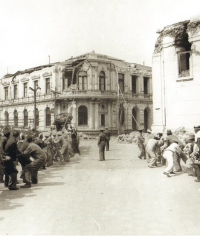Gil, M (2022), Latin American Research Review , First View, pp. 1 – 19
Disasters as Critical Junctures: State Building and Industrialization in Chile after the Chillán Earthquake of 1939. Latin American Research Review , First View, pp. 1 – 19
Este paper es open access y pueden verlo completo acá: DOI: https://doi.org/10.1017/lar.2022.53
Abstract
In 1939 an earthquake destroyed south-central Chile, especially the city of Chillán. This event was arguably the most catastrophic socio-natural disaster in Chilean history, yet it has been mostly ignored in historical research. This article shows that the earthquake triggered a critical juncture for the Chilean state and was a determining factor in some of the most important institutional developments of the period. Using primary sources, the article describes this juncture, focusing on the destabilizing effect of the earthquake and linking it to the creation of two new state institutions, the Production Development Corporation (CORFO) and the Reconstruction and Assistantship Corporation (CRA), together with other important changes in state capacities. It concludes that the disaster is crucial in understanding the Chilean transition from an exporting economy to an import-substituting one after 1940, and to account for the strength of the Chilean state in the decades to come.
Resumen en español
En 1939 un terremoto destruyó el centro-sur de Chile, especialmente la ciudad de Chillán. Este evento es probablemente el desastre socio-natural más catastrófico de la historia de Chile. En este artículo, se muestra que el terremoto de 1939 fue un factor determinante para algunos de los desarrollos institucionales más importantes del período, generando una coyuntura crítica para el Estado chileno. Mediante el uso de fuentes primarias, se describe esta coyuntura, mostrando el efecto desestabilizador del terremoto y vinculándolo a la creación de dos nuevas instituciones públicas, la Corporación de Fomento de la Producción (CORFO) y la Corporación de Reconstrucción y Auxilio (CRA), junto con otros cambios importantes en términos de capacidad estatal. Se concluye que la catástrofe es crucial para entender la transición chilena desde una economía exportadora a una de sustitución de importaciones después de 1940, y para dar cuenta de la fortaleza del Estado chileno en las décadas siguientes.

